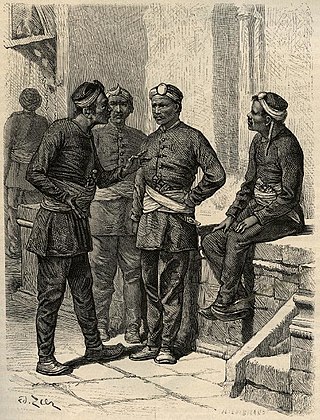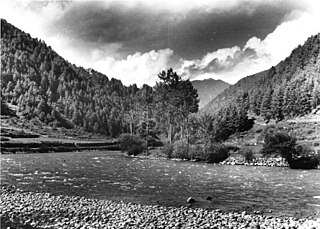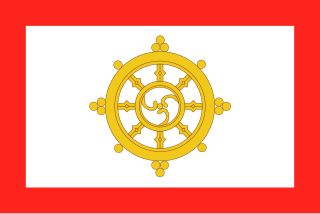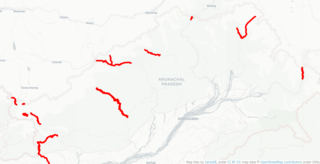
Sikkim is a state in Northeastern India. It borders the Tibet Autonomous Region of China in the north and northeast, Bhutan in the east, Province No. 1 of Nepal in the west and West Bengal in the south. Sikkim is also close to the Siliguri Corridor, which borders Bangladesh. Sikkim is the least populous and second smallest among the Indian states. Situated in the Eastern Himalaya, Sikkim is notable for its biodiversity, including alpine and subtropical climates, as well as being a host to Kangchenjunga, the highest peak in India and third highest on Earth. Sikkim's capital and largest city is Gangtok. Almost 35% of the state is covered by Khangchendzonga National Park – a UNESCO World Heritage Site.

The Gurkhas or Gorkhas, with endonym Gorkhali[ɡorkʰali]), are soldiers native to the Indian Subcontinent, chiefly residing within Nepal and some parts of Northeast India.

The history of Sikkim, begins with indigenous Lepchas contact with early Tibetan settlers. Historically, Sikkim was a sovereign Monarchical State in the eastern Himalayas. Later a protectorate of India followed by merger with India and official recognition as a state of India. Lepchas were the main inhabitants as well as the Ruler of the land upto 1641. Lepchas are generally considered to be the first people, indigenous to Sikkim also includes Darjeeling.

The 11 Gorkha Raigment is a Gorkha regiment of the Indian Army that was re-raised after independence. The regiment consists of primarily the Kirant Tribes Rai, Limbu, Yakkha, Sunuwar of Eastern Nepal, Darjeeling, Kalimpong, Dooars of West Bengal, Sikkim and other parts of Northeast India. Though it is considered to be the youngest of the Gorkha regiments its lineage is as long as those of the 7th Gurkha Rifles and 10th Gurkha Rifles.

The Kumaon Regiment is one of the oldest infantry regiments of the Indian Army. The regiment traces its origins to the 18th century and has fought in every major campaign of the British Indian Army and the Indian Army, including the two world wars, and is one of the highest decorated regiments of the Indian army.

The Chumbi Valley, called Dromo or Tromo in Tibetan, is a valley in the Himalayas that projects southwards from the Tibetan plateau, intervening between Sikkim and Bhutan. It is coextensive with the administrative unit Yadong County in the Tibet Autonomous Region of China. The Chumbi Valley is connected to Sikkim to the southwest via the mountain passes of Nathu La and Jelep La.

The Special Frontier Force (SFF) is an Indian special operations unit created on 14 November 1962. It mainly comprised Tibetan refugees living in India. Now it has increased in size and scope of operations. Its primary goal originally was to conduct covert operations behind Chinese lines in the event of another Sino-Indian War.

The Assam Regiment is an infantry regiment of the Indian Army. The regiment consists of 25 battalions: 17 regular battalions, 3 Rashtriya Rifles battalions, 5 Territorial Army battalions. It recruits exclusively from all the eight Northeastern states of India.

The Sino-Indian border dispute is an ongoing territorial dispute over the sovereignty of two relatively large, and several smaller, separated pieces of territory between China and India. The first of the territories, Aksai Chin, is administered by China as part of the Xinjiang Uygur Autonomous Region and Tibet Autonomous Region and claimed by India as part of the union territory of Ladakh; it is mostly uninhabited high-altitude wasteland in the larger regions of Kashmir and Tibet and is crossed by the Xinjiang-Tibet Highway, but with some significant pasture lands at the margins. The other disputed territory is south of the McMahon Line, in the area formerly known as the North-East Frontier Agency and now called Arunachal Pradesh. The McMahon Line was part of the 1914 Simla Convention signed between British India and Tibet, without China's agreement. China disowns the agreement, stating that Tibet was never independent when it signed the Simla Convention.

The Kingdom of Sikkim, officially Dremoshong until the 1800s, was a hereditary monarchy in the Eastern Himalayas which existed from 1642 to 16 May 1975, when it merged with the Republic of India. It was ruled by Chogyals of the Namgyal dynasty.

Sashastra Seema Bal is a border guarding force of India deployed along its borders with Nepal and Bhutan. It is one of the seven Central Armed Police Forces under the administrative control of the Ministry of Home Affairs (MHA).
The Arunachal Scouts is an infantry regiment of Indian army based in Arunachal Pradesh. Specialising in mountain warfare the regiment was established with the purpose of defending the Indian-Chinese border in Arunachal Pradesh. A large proportion of the Arunachal Scouts are local to the region in which they work. Previously Part of the Indian Army’s Assam Regiment, the Arunachal Scouts consist of two battalions, the first raised in 2010 and second in 2012.

The Ladakh Scouts is an infantry regiment of the Indian Army, nicknamed as the "Snow Warriors" or "Snow Leopards". The regiment specializes in mountain warfare, and its primary role is to guard India's borders in the high altitudes of the Union Territory of Ladakh.

The Indian military bands consists of musicians from the Indian Army, Navy and Air Force. Indian military bands regularly participate in international festivals and take part in celebrations dedicated to various national events. These bands are permanent participants in the Delhi Republic Day parade on the Rajpath. Today, the Indian Armed Forces have more than 50 military brass bands and 400 pipe bands and corps of drums. A Tri-Services Band refers to a joint Indian Armed Forces military band that performs together as a unit. At the Spasskaya Tower Military Music Festival and Tattoo in Moscow, the band consisted of 7 officers and 55 musicians. The Military Music Wing of the Army Education Corps is the principal educational institution of the armed forces that provides instruction to musicians of all ranks. Instruction is also provided by the Military Music Training Center and the Indian Navy School of Music.
Officers and soldiers of the Indian Army wear cap badges on their beret or peaked caps. The design is based on the regimental insignia or coat of arms.

India–China Border Roads is a Government of India project for developing infrastructure along the Sino-Indian border by constructing strategic roads, including bridges and tunnels. The ICBR project is largely in response to Chinese infrastructure development along the borderlands with India.
Scouts in the British Empire meant a locally raised standing paramilitary, not part of the British Army or British Indian Army, under the command of a local Chief or commissioner, but with attached British officers. Scouts were internal and border security units composed of locals, officered by British officers.
Indian order of battle during the 2020–2021 China–India skirmishes:















